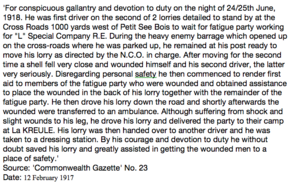
S7978
BRIDGLAND, George Reginald
| Service Number: | 2087 |
|---|---|
| Enlisted: | Not yet discovered |
| Last Rank: | Driver |
| Last Unit: | 300th Company Mechanical Transport |
| Born: | Adelaide, South Australia, 1893 |
| Home Town: | Brighton, Holdfast Bay, South Australia |
| Schooling: | Not yet discovered |
| Occupation: | Fitter & Turner |
| Died: | 1965, cause of death not yet discovered, place of death not yet discovered |
| Cemetery: | Not yet discovered |
| Memorials: | Brighton Arch of Remembrance |
World War 1 Service
| 22 Dec 1914: | Involvement 2087, 300th Company Mechanical Transport, --- :embarkation_roll: roll_number: '22' embarkation_place: Melbourne embarkation_ship: HMAT Ceramic embarkation_ship_number: A40 public_note: '' | |
|---|---|---|
| 22 Dec 1914: | Embarked 2087, 300th Company Mechanical Transport, HMAT Ceramic, Melbourne | |
| 11 Nov 1918: | Involvement Driver, 2087 |
Help us honour George Reginald Bridgland's service by contributing information, stories, and images so that they can be preserved for future generations.
Add my storyBiography contributed by St Ignatius' College
George Reginald Bridgland (service number 2087) was born to George James Bridgland and Edith Bridgland (nee Searle) in 1893. He was born into a small house on Jetty Beach Road, Brighton, South Australia. He lived with his 2 siblings, Lionel Searle Bridgland and one other. (Soldier 2015)
George had a regular schooling and attended the local school until the age of 18. Then, at the age of 19, George acquired a job. His job was a Fitter, which at that time was a person who operated machines to produce parts or tools and maintained and repaired them. (Fitter 2013)
A few years later, George decided to sign up for the war at the age of 21. He enlisted in Melbourne on the 16th of September 1914 and soon after, embarked on the 22nd of December 1914 on board the HMAT A40 Ceramic. He arrived at the battlefield as part of the British Army and as an ANZAC.
The unit that George was placed in was the ‘1 A.M.T.S’, which stands for the first rank of the Australian Mechanical Transport Service. His subdivisional rank for this unit was in the 300th Mechanical Transport Army Service Corps (17th Divisional Ammunition Column) (9th Army Service Corps). He stayed here throughout the entirety of the war and his job in the Army was to be a driver. A driver is equivalent to the rank of a Private. It was initially used to name the ranks of men who drove the carts drawn by horses that held the guns on them, but they were renamed after the World Wars as ‘gunners’. (Driver 2014)(WW1 Abbreviations 2015)
During the war, George Reginald Bridgland did a very heroic and brave act. Whilst he was driving a cart, a shell landed very close to him and he was blown from the carriage. Whilst no-one died, he still smarted severe leg injuries and suffered from shock. Despite this, George did what few other men would have been brave enough to do and, disregarding his own safety, continued to help load as many wounded soldiers in the area onto his cart, which was later transported to the hospital nearby. His actions saved many men that day. (Soldier 2015)(Collection 2015)
When the war finally ended in 1918, George was shipped back to Australia on the 23rd of October. (Soldier 2015)
He returned safely home to Adelaide, where he was commended for his important work during the war and was awarded 4 medals. The first medal he received was the Victory Medal, which was a medal that commemorated the fact that he was a soldier that helped the British army to win the war. The second medal that he won was the 1914-15 Star Medal. This medal was a four pointed, bronze star with a crown inside of it which was awarded for service in specific theatres of war between 5th August 1914 to 31st December 1915. The third medal that George won was the British War medal. This medal was given by King George V to mark the end of the World War and record the service given.
The last medal that George received was a special Military Medal. These medals were only given to those special soldiers who did something important and brave during the war. George was awarded this medal for the brave act he did on the battle field when the shell landed near him. A special speech was given in his honour. (Collection 2015)(Medals 2013)
An Australia Remembers Journal has also been written about him and is now on display at the Australian War Memorial in Canberra. (War Memorial 2012)
Life after the war was very peaceful and happy for George. Once he returned, he went back to living in his house with his parents before marrying Constance Victoria Buxton Bridgland (nee Gregory). Together they had 2 children; Brenda Elizabeth Marwick (nee Bridgland) and one other child. However, after many years, Constance died due to unknown reasons and George re-married to a woman name Elsie Bridgland. (Soldier 2015)(Collection 2015)
George died at the old age of 72 in 1965 and was buried in the Saint Jude Cemetery, Brighton, South Australia, Australia. (Cemetery 2012)















